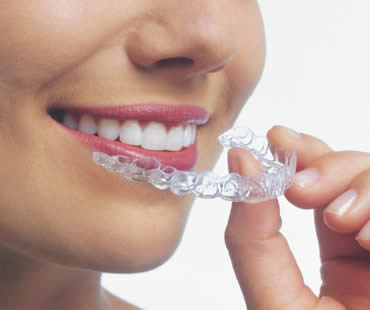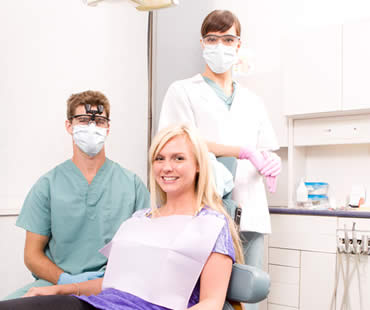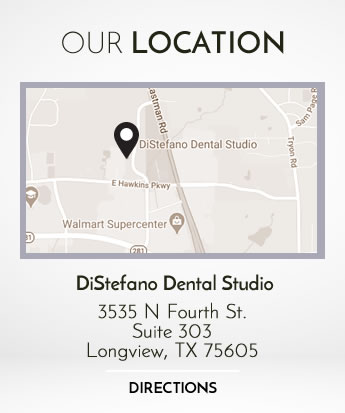
If you are either planning to undergo cosmetic dental procedures or necessary treatments for dental problems, there is a case to be made for considering sedation dentistry. Sedation dentistry refers to the use of medications in varying forms to calm and relax you prior to and during a dental procedure. Just a few reasons to consider dental sedation include:
- Dental sedation can be used for essentially all regular dental procedures. Under sedation, your dentist can accomplish far more in one appointment, meaning less overall time for you in the dental chair. Procedures that may normally take 2 or 3 visits to the dentist can be completed all in one visit with the help of dental sedation.
- Normally, dentists do not like to work on both sides of the mouth at the same time as this requires anesthesia to each side and could cause the patient to bite their tongue. Sedation dentistry allows your dentist to work on both sides of the mouth in one sitting.
- Dental sedation allows you to feel relaxed and free from stress while the actual procedure is being performed. In many cases, even though you are still conscious, you will not remember any of the actual time you spent in the dentist chair.
With sedation dentistry, there is no need to dread dental treatments and procedures. Your fears and anxiety should not deter you from seeking the cosmetic or restorative dental care that you desire. Consult with your dental professional about the options offered for sedation, and schedule your oral care with the confidence that you will have a calm and pleasant experience while improving your smile.
Our dental office is located in Longview

Many types of cosmetic dentistry procedures such as crowns, bridges, tooth implants, or other invasive procedures require some kind of anesthesia in order to be performed in comfort for the patient. Even a procedure like porcelain dental veneers can be aided by the addition of some kind of sedation dentistry, especially if the patient is experiencing anxiety or fear regarding the treatment. For any patient seeking a more relaxed cosmetic dental experience, sedation dentistry presents several options.
Inhaled sedation, or nitrous oxide, is more commonly known as “laughing gas.” It is inhaled via a mask and is controlled by your dentist. It is a light sedation, and allows you to remain completely responsive and compliant to instruction. Nitrous oxide sedation wears off quickly; because of this, you may be able to drive yourself home after your treatment.
Conscious oral sedation reduces your anxiety while still allowing for responsiveness to requests and directions. Oral sedatives are typically prescribed in pill form, and can be taken up to an hour before your dental procedure. Some dentists believe that taking a mild oral sedative the night before treatment can alleviate anxiety and ensure proper rest. You should not drive yourself home if you have taken an oral sedative for your dental treatment. You will not be fully alert.
IV sedation is also known as “sleep dentistry.” It provides the most relaxed dental experience, allowing you to be deeply sedated while never completely unconscious. A natural effect of the drugs is full or partial memory loss of the time during its use, so you may have no memories of your procedure. You should never drive following IV sedation, and you may not be fully alert for several hours. Plan to go home, rest, and sleep.
Your cosmetic dentist wants you to be comfortable throughout your dental therapy and will know which sedation dentistry option is right for your particular cosmetic dentistry procedure. Talk to your cosmetic dentist today about any concerns you have regarding your treatment so that you may have the most positive, pain and anxiety-free experience possible.
We look forward to seeing you in our Longview dental office

Being a teenager can be difficult, and being a teen whose smile could use some improvement can be even more difficult. If your teen suffers from gapped, crooked, crowded, or misaligned teeth, you may be looking into Invisalign with your teen’s orthodontist as a smile solution.
In the past, metal braces were the standard for teens, leading to “metal mouth” smiles and the worry that food is caught there during lunch or after snacks. Metal braces can lead to even more self-consciousness for your teen. Using Invisalign will lead to the same results as traditional metal braces. While metal braces use wires and brackets to straighten teeth, Invisalign uses clear plastic trays, allowing your teen’s process of tooth straightening to be less obvious.
The Invisalign process begins with impressions and x-rays, providing valuable information regarding the current condition of your teen’s teeth. The mold made from the impressions serves as the reference for creating the custom-made Invisalign trays. A series of trays are used, gradually altering the teeth, leading to a more comfortable straightening process.
Invisalign trays are removed before eating, eliminating the trepidation associated with eating in public with traditional metal braces. Because there is no hardware to dislodge, there are no food restrictions, and your teen may continue to enjoy whatever foods desired.
Your teen will need to have good oral hygiene habits. Flossing once a day and brushing after mealtimes or at least twice a day is best. Invisalign trays are removed prior to these activities, allowing for an ease of oral care not provided by traditional braces.
Be sure your teen wears the Invisalign trays as recommend by his or her orthodontist. In order to maximize Invisalign effectiveness, your teen must wear the trays at all times, except during mealtimes or when brushing or flossing.
Schedule your appointment at our Longview dental office

Does your child need braces, but isn’t sure about being a “metal mouth” for two or more years? Did your teen come to you and beg for some other option to traditional braces? Perhaps you’ve heard about Invisalign aligners but are wondering if they’ll work for your child. Invisalign is absolutely appropriate for your teen if all of his or her baby teeth have fallen out and adult teeth have erupted.
Invisalign provides the same results as traditional metal braces, but without the metal brackets. Concerns over eating with braces are removed with the Invisalign trays, as they come out for meals, leaving your teen free to eat any food he or she desires.
Invisalign utilizes clear plastic trays that allow the process of straightening your teen’s teeth to be less obvious and less obtrusive. Beginning with x-rays and molds, your orthodontist will make a series of trays, called aligners. These trays are worn most of the day, taken out only to eat or to be cleaned. The process of straightening happens gradually and comfortably.
It is essential during this time that the trays are worn as recommended by the orthodontist. Wearing them less than the recommended amount of time will result in slower correction, and has the potential to lengthen treatment. Have your teen continue with any established good oral hygiene habits. Brushing and flossing must continue on a regular basis, brushing twice a day at minimum and flossing before bedtime.
Being a teenager is full of difficulties, and it is during this time that teens are at their most self-conscious. Adding metal braces to this transition can make everything worse for your child, leaving him or her self-conscious about eating with friends or smiling, talking or laughing in public. Your teen’s gapped, misaligned or crowded teeth can be improved significantly with Invisalign trays. Talk to your orthodontist today to see how Invisalign can make a difference for your child.
We treat patients from Longview and the surrounding area

Once you and your dental professional have agreed on conscious dental sedation for use during your dental treatment, there are a variety of ways in which it can be administered.
Inhalation sedation or the use of nitrous oxide (laughing gas) is a light form of conscious sedation. Your sedation dentist will administer a combination of nitrous oxide and oxygen through a mask that is placed over your nose. During the procedure, you inhale the gas through your nose and back out through your mouth. Nitrous oxide wears off almost immediately upon completion of the procedure with minimal to no recovery time or side effects.
Oral medication used for sedation purposes produces medium or moderate sedation effects, depending on the strength of the prescription administered by your sedation dentist. Oral sedation usually comes in pill form and is taken approximately one hour prior to the procedure. You may feel sleepy, but should still be able to respond to your dentist’s commands. Recovery time is longer with oral sedation, and requires someone to drive you home. Side effects are rare, but may include nausea or vomiting.
Another moderate form of conscious sedation is intravenous (IV) sedation. In the case of IV sedation, the drugs are administered directly into your veins through a needle. The effects of IV sedation are much quicker than oral sedation. IV sedation allows your dental professional to adjust the levels of sedation during treatment. With IV sedation, you may begin to feel alert soon after the medication has stopped; however, you should not drive or operate heavy machinery for at least 24 hours after the procedure.
Conscious sedation should only be performed by a dental professional with appropriate training. Your sedation dentist will consider your health history when choosing the appropriate form of sedation to best suit your needs. While conscious sedation is considered safe, it is best to work with a qualified sedation dentist to determine the best form of administration for your dental treatment.
If you need a dentist in Longview contact us today

Sedation dentistry provides a way for those who experience anxiety or fear about visiting the dentist to get the treatment they need. It is also helping in relieving pain, and enabling more dental work to be performed in one visit. Two common methods of administering sedation are oral and intravenous (IV). Each type has its own unique characteristics and attributes.
Oral sedation involves swallowing pills or liquids. There are no shots, which is good news for patients afraid of needles. However, oral sedatives are less predictable because each medication affects people differently based on age, weight, medical history, and more. Also, there is a time delay between swallowing it and taking effect. Since the medication is absorbed through digestion, it is difficult to alter the sedation level quickly during treatment. Nearly all patients respond well to oral sedation, with few occurrences of any side effects. Patients typically don’t remember anything that occurred during treatment.
IV sedation means that the medication goes directly into the blood stream though an IV injection. A very powerful method, the effects are instant once the shot is given. If the medication begins to wear off, more can be administered through the IV for immediate results. IV sedation is very common during oral surgeries, which benefit from the ability to alter the medication dosage as needed. It is advantageous for long procedures or when multiple treatments are being done in one sitting. Patients will not remember the procedure or sometimes even the appointment at all. The biggest drawback of IV sedation is for patients who dislike needles. IV sedation requires that the dentist have special training and certification, so make sure that your dentist is qualified if this method is offered.
Both types of sedation can be effective depending on the situation and patient. Discuss your case with your dentist to help you decide which one might be the best for you.
We look forward to seeing you in our Longview dental office









